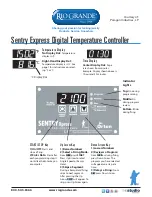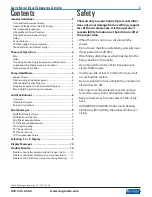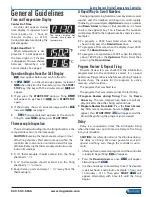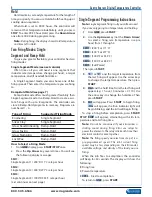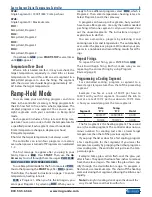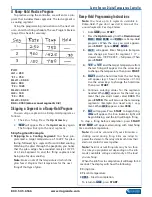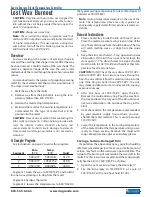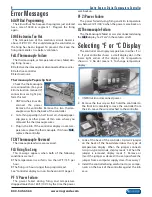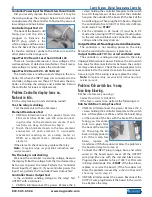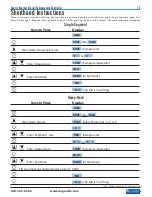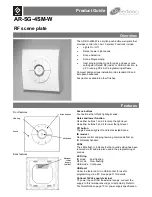
800.545.6566
www.riogrande.com
Sentry Express Digital Temperature Controller
8
Sharing your passion for making jewelry.
Products. Service. Know-how.
Lost Wax Burnout
CAUTION:
Only kilns with vent holes are designed for
lost wax burnout. However, you may be able to use a
kiln without the vent hole provided that you open the
door
½
” during venting.
CAUTION:
Always use a wax tray.
Note:
These instructions apply to injection wax that
melts at 200
°
F, not pattern waxes and plastics that melt
at higher temperatures. If smoke appears during wax
elimination, turn off the kiln. Smoking wax means the
kiln fired hotter than 300
°
F/148
°
C.
Overview
Lost wax casting is the process of carving a shape in
wax and then casting that shape in metal. After the wax
has been carved, a mold is made of the wax shape. The
mold is a negative image of the wax. The wax is later
melted out of the mold through hollow channels called
sprues.
Lost wax burnout is the process of preparing a casting
mold for the melted metal that will be poured into it.
The steps in lost wax burnout.
1. Melt the wax from the mold.
2. Remove wax from the kiln before raising the tem-
perature higher than 300°F/148°C.
3.
Harden the mold at high temperature.
4. Maintain the mold at the casting temperature rec-
ommended for the type of metal that will be
poured into the mold.
CAUTION:
Prevent wax or carbon from contacting the
kiln’s walls and elements. Carbon build-up inside a kiln
ruins the interior. Carbon conducts electricity and
causes elements to short circuit. Damage to elements
from contact will foreign materials is not covered by
warranty.
A Sample Program
See instructions on page 7 to enter this program:
Segment
Rate
°
F/
°
C
Temp.
°
F/
°
C
Hold
1
500/277
300/148
01.00
2
500/277
1350/732
01.00
3
450/250
800/426
02.00
Segment 1 heats the wax to 300°F/148°C and holds it
for one hour, allowing it to drip from the mold.
Segment 2 hardens the mold.
Segment 3 lowers the temperatures to 800°F/426°C,
the typical casting temperature for silver. (Most types of
gold cast at 900°F/482C)
Note:
Casting temperature depends on the size of the
mold. The temperatures above are only a guide. See
your jewelry supply dealer for temperature recommen-
dations.
Burnout Instructions
1. Place a metal tray inside the kiln on three ½” posts.
Place the mold on a wire mesh screen on top of the
tray. The mold’s sprue hole should be down. The tray
will catch melting wax as it drips from the sprue
hole.
2. Keep the kiln’s vent hole(s), if any, open during wax
elimination. If the kiln has no vent hold, leave the
door open ½”. This allows fumes to escape the kiln.
Heat the kiln to 300°F/148°C and hold it at that tem-
perature for at least one hour.
CAUTION:
Do NOT heat the wax above 300
°
F/148
°
C.
Hold at 300
°
F/148
°
C for at least one hour. During this
hour, the wax will melt from the mold and drip into the
tray. If the kiln gets hotter than 300
°
F/148
°
C, the wax
may smoke and deposit carbon inside your kiln, causing
expensive damage.
3. After one hour at 300°F/148°C, open the kiln.
Remove the mold and wax tray. Pour the wax from
the tray and leave the tray out of the kiln until your
next wax elimination. (Do not leave the tray in the
kiln!)
4. Heat the mold to the temperature recommended
by your jewelers’ supply house where you pur-
chased the mold material. This is usually around
1350°F/732°C.
5. Lower the temperature to the casting temperature
of the metal. Hold at that temperature until you are
ready to begin casting. Remove the mold with
tongs. Wear protective gloves and safety glasses.
Saving a Carbon-Damaged Kiln
If you follow the above directions, your kiln should be
safe from wax damage. In some cases, a small amount of
carbon may form on the walls over a period of time. This
is due to the burning of wax residue that was left in the
mold. For this reason we recommend that you periodi-
cally fire the kiln to 1500°F/815°C as follows:
1. Open the vent cover(s) or leave the door ajar ½”.
2. Fire the kiln empty to 1500°F/815°C at a rate of
300°F/166°C with a one hour hold (01.00).

